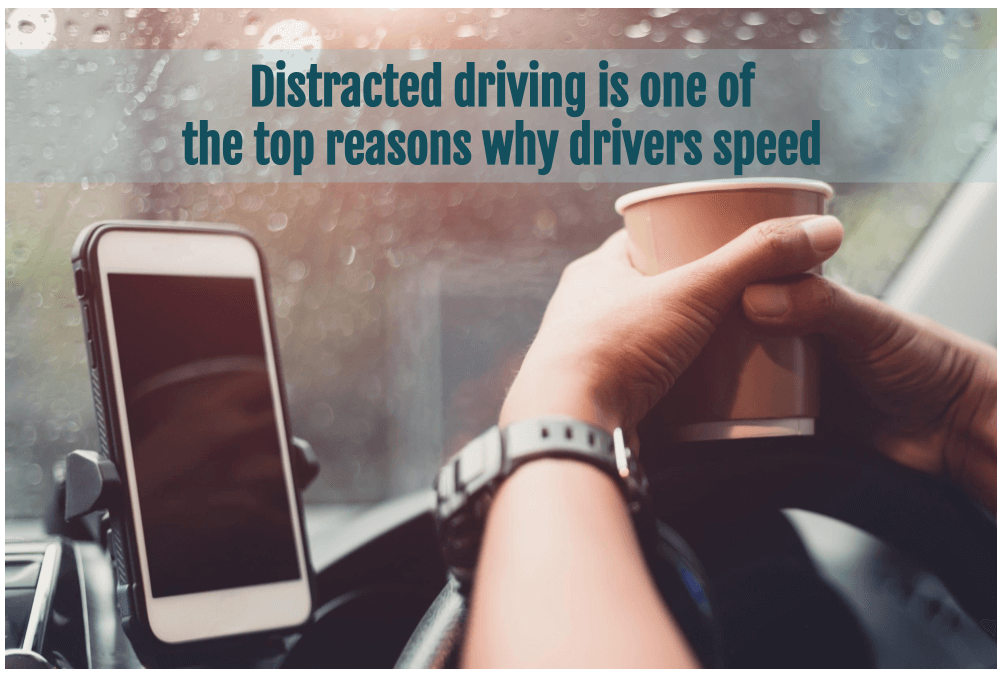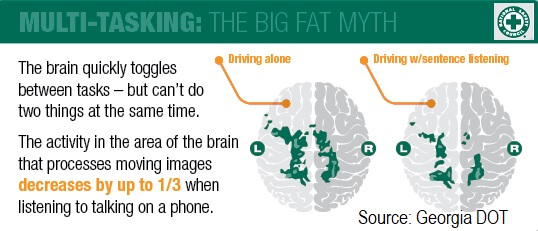Speeding, Distracted Driving and Radar Speed Signs:
The Science that Connects Them

Distracted driving is one of the top reasons why drivers speed. Yet, we often overlook the relationship between driver speed and driver distraction as an opportunity to solve the distracted driving epidemic. This is probably because the majority of distractions come from within the vehicle. Mobile phones, radios, passengers, a hot cup of coffee and more can divert a driver’s attention.
It’s during these periods of distracted driving that brain activation shifts dramatically, impairing a driver’s cognitive abilities making them unable to multitask safely. Everyone knows that driver behaviors must change. The question is, “How do we change them?” We can regulate driver behavior with legislation, like hands-free laws. But that approach still relies on driver compliance. To be more effective, regulations should be paired with external forces that automatically remind drivers to focus on the job of driving. Radar speed signs, one of the most reliable traffic calming solutions, are already scientifically proven to do this: they work because they prompt drivers to change how they operate their car.
Radar Speed Signs Trigger Changes in Distracted Driver Behaviors by triggering feedback loops.
Wired Magazine describes feedback loops as a centuries-old strategy that is “profoundly effective” in affecting behavioral changes. The concept is simple: “Provide people with information about their actions in real time (or something close to it), then give them an opportunity to change those actions, pushing them toward better behaviors. Action, information, reaction.”
Distracted drivers typically fail to maintain speed, driving faster or slower than the posted speed or other drivers. Whether these drivers are going too slow or too fast, they need a trigger, a neurobehavioral activator, to convert from a distracted state to engaged state. Radar speed signs provide that trigger.
Used as part of a larger, comprehensive strategy to combat distracted driving radar speed signs can serve a dual purpose: to regulate driver speeds and to redirect drivers’ attention back to the task of driving. Both of which can save lives.
STATS ON DISTRACTED DRIVING AND SPEEDING IN THE U.S.
The human toll attributed to distracted driving is heavy. In 2016, distracted drivers caused 3,450 deaths and, in 2015, distracted drivers injured more than 391,000 people in crashes.
Distracted Driving (defined): The diversion of attention from activities critical to the task of safe driving can include: eating and drinking, talking to people in your vehicle, fiddling with the stereo, entertainment or navigation system, or talking or texting while driving. It is urgent that we redirect the drivers’ attention back to the vital task of safe driving.
- Distraction is one of the top reasons behind why drivers speed. [Source: Cornell Insurance Study 2014]
- Drivers distracted by a mobile phone are nearly 3x more likely than other drivers to exceed the speed limit by 10 mph or more. [Source: Omnitracs 2021 survey]
- During distracted driving, brain activation shifts dramatically. [Source: NCBI (National Center for Biotechnology Information)]
- Distracted driving reduces brain activity associated with driving by 37%. [Source: Carnegie Mellon University
 ]
] - Distracted driving results in variable speeds: vehicle speeds that are unpredictable, too slow and too fast for conditions.
- Distracted drivers speed up and slow down without warning. [Source: Accident Analysis and Prevention]
- Distractions impair driver’s cognitive abilities making them unable to multitask safely. [Source: National Safety Council]
- People typically do not realize when they are cognitively distracted. [Source: National Safety Council]
- 52% of drivers admit to engaging in distracting activities while driving, even though they know it’s wrong. [Source: Forbes.com/Consumer Reports]
- There are three types of distracted driving.
- Manual distractions are those where the driver moves his/her hands away from the task of controlling the vehicle.
- Visual distractions are those where the driver focuses his/her eyes away from the road.
- Cognitive distractions are when a driver’s mind wanders away from the task of driving.
- Some 10% of fatal crashes, 15% of injury crashes and 14% of all police-reported motor vehicle crashes in 2015 were reported as “distraction affected” crashes.
About Radarsign® Brand Radar Speed Signs:
In 2004, Atlanta-based Radarsign® established new industry standards for traffic calming solutions with the debut of the world’s first armored driver feedback signs. Radarsign radar speed signs are vandal-, weather- and bullet-resistant. They are also the traffic calming industry’s most durable, most ecological and most energy efficient radar speed signs. Engineered and manufactured in the USA, all Radarsign models are MUTCD-compliant and utilize recycled aluminum, innovative LED reflector technology, minimal battery power and solar panels to deliver bright, easy-to-read feedback to drivers. Radarsign products are scientifically proven to reduce drivers’ speeds and have been entrusted to provide safe and effective traffic calming solutions for: municipalities, treasured national parks, schools, neighborhoods, military bases, and private and public development projects across the U.S., Canada and overseas. www.radarsign.com.
©2019 Radarsign. Any use of “Traffic Calming Trends” or portions thereof, including reproduction, modification, distribution or republication, without the prior written consent of Radarsign, is strictly prohibited.
